In the Capa Archives (d)
Aside from Robert Capa’s younger brother Cornell, no one had greater access to all materials relating to Robert’s life and work than the late Richard Whelan (1946-2007). As the authorized biographer of both men, and the original “Consulting Curator” of the Robert Capa and Cornell Capa Archive at the International Center of Photography, Whelan researched and organized multiple exhibitions and publications devoted to both Capas, as well as to Robert’s lover Gerda Taro and others in their circle. He also lectured widely and taught on those subjects. To do so, with Cornell’s blessing he drew on a wide range of primary source materials, many of them in Cornell’s private collection, and generated additional materials through his interviews.
This makes him, de facto, the primary authority on everything relating to Robert Capa’s life and work. However, two factors undermine the credibility and usefulness of his work. First, we have to take into account the bespoke nature of his long-term labors on behalf of Capa — all variously sponsored, funded, and otherwise enabled by Cornell Capa, by the Capa estate, and by the International Center of Photography, an institution built in part on the life, the work, and the legend of Robert Capa, and involved from its 1974 inception till today in promulgating them.
Second, we have to address Whelan’s cavalier approach to scholarship. Whelan provided bibliographies and lists of interviewees, but didn’t consider it necessary to use footnotes, endnotes, or in-text citations to indicate the specific documents (and precise locations therein) or other sources from which he ostensibly gleaned the data and information he presents in his biographical and curatorial texts.
Thus he leaves the reader unable to verify almost all of his assertions, reduced to taking them on faith. To call this unorthodox hardly does it justice. (Compare, if you have access to them, Whelan’s nonexistent notes for his 1985 Capa biography with Jim Hughes’s ample notes — 50 printed pages’ worth of small type — for his 1989 biography, W. Eugene Smith: Shadow and Substance — The Life and Work of an American Photographer.) The lack of concrete references definitely enhances the hagiographic ambiance of Whelan’s Capa projects.
Fish Story
Take, for example, the following passage from Whelan’s catalogue for the 2007 ICP show “This Is War! Robert Capa at Work,” referring to “Capa’s caption notes made aboard the U.S.S. Henrico“:
“[B]efore he left the Henrico on D-Day morning he entrusted all the rolls of film that he had shot until then to a ship’s officer to relay back to London. The films were developed and passed by the censor during D-Day.” (p. 224)
This seemingly innocuous paragraph marks the debut of a momentous claim — that Capa actually sent John Morris two separate shipments of film via two different couriers: the first, his pre-invasion films, arriving June 6 and getting processed, printed, and put through the censorship system that same day; the second, his Omaha Beach films, arriving late on the 7th, processed and printed that night, censor-vetted the next morning, and rushed to LIFE in New York.
Nothing in Capa’s account of those eventful days supports the notion that he transferred from the U.S.S. Samuel Chase to the Henrico before the landing. Nor does he mention shipping his pre-invasion films to Morris before heading to Omaha Beach. Capa’s 1947 book Slightly Out of Focus hardly qualifies as a reliable source, as Whelan takes great pains to remind his readers in both the 1985 biography and the 2007 catalogue. (“Capa did not intend his book to be an historically accurate account of events. He wrote it to serve, with little alteration, as the basis for a fast-moving and entertaining screenplay. … Slightly Out of Focus is, in effect, an autobiographical novel.” This Is War! pp. 222-23.) However, absent any hard data to the contrary, we have to take seriously his telling of the tale.
Moreover, Whelan’s newly minted version of the story directly contradicts that of John Morris, who has insisted in dozen of accounts over the part 70 years that the London office of LIFE heard nothing from Capa from the time he embarked from Weymouth, England with the troops through the afternoon of D-Day, June 6, leaving the five-man darkroom staff twiddling their collective thumbs and all of them, Morris most of all, in a state of high anxiety re the imperative of meeting LIFE‘s looming deadline. (Failure to do so could have cost Morris his job.)
I can’t imagine Morris omitting a detail of such magnitude — the arrival of a preliminary shipment of Capa’s pre-invasion film, the processing and printing of which (not to mention the navigation of the censorship system with the results) would have taken hours. Nor can I see him neglecting to mention that he’d either sent them to New York immediately or saved them for bundling with Capa’s pictures of the landing.
Turning to the endnotes for this passage, to check Whelan’s documentation for these claims (neither of which appear in his 1985 biography), one finds — nothing. Nothing at all. Which makes his innovative story questionable, to say the least.
The Ones that Got Away
 I’d hoped to examine Whelan’s drafts and notes for that catalogue during my visits to the ICP’s Capa Archive, but Cynthia Young assures me that they don’t hold any of his Capa-related materials beyond a few pages of sketchy notes. And the Center for Creative Photography in Tucson, Arizona, to which Whelan willed his papers before taking his own life just months before the show’s premiere, informs me that his Capa-related materials do not form part of that bequest. According to Leslie Squyres, Director of the CCP’s Volkerding Study Center, “The Richard Whelan Archive does not include information on Robert or Cornell Capa or on Gerda Taro either. I do not know where the material for that research ended up — I always assumed that it was housed at ICP.”
I’d hoped to examine Whelan’s drafts and notes for that catalogue during my visits to the ICP’s Capa Archive, but Cynthia Young assures me that they don’t hold any of his Capa-related materials beyond a few pages of sketchy notes. And the Center for Creative Photography in Tucson, Arizona, to which Whelan willed his papers before taking his own life just months before the show’s premiere, informs me that his Capa-related materials do not form part of that bequest. According to Leslie Squyres, Director of the CCP’s Volkerding Study Center, “The Richard Whelan Archive does not include information on Robert or Cornell Capa or on Gerda Taro either. I do not know where the material for that research ended up — I always assumed that it was housed at ICP.”
 Nor did he deposit them at the Robert Capa Contemporary Photography Center in Budapest, according to Marta Hampl of that organization.
Nor did he deposit them at the Robert Capa Contemporary Photography Center in Budapest, according to Marta Hampl of that organization.
In short, all the supporting documentation gathered by Whelan over the almost four decades of his multifaceted Capa project, plus his finished manuscripts, drafts, and research notes, have vanished.
Hmmm.
Mackerel by Moonlight
This becomes even more suspicious when one factors in Whelan’s implausible revision of the now-disproved melting-emulsion/darkroom-disaster fable concerning the fate of Capa’s Omaha Beach negatives, as broached in my previous post. After reiterating verbatim the myth of the overheated film-drying cabinet cooked up by John Morris, he elaborates thus in the catalogue for This Is War!:
Although eleven of the 35mm images were usable, they had not completely escaped being damaged. The emulsion on them had melted just enough so that it slid a bit over the surface of the film. Consequently, sprocket holes — which would normally punctuate the unexposed margin of the film — cut into the lower portion of the images themselves. Ironically, the blurring of the surviving images may actually have strengthened their dramatic impact, for it imbues them with an almost tangible sense of urgency and explosive reverberation.
The last sentence in that quote Whelan took from his own 1985 authorized biography of Capa; the rest makes its debut in this catalogue.
Alas for Whelan, and his reputation, this constitutes not just an error but a lie. I use the term advisedly, for three reasons, each of them verifiable via the physical evidence:
1. The contact sheets of Capa’s pre-invasion images of the troops boarding at Weymouth and en route to Normandy show exactly the same intrusion of the sprocket holes into the image area as do the nine surviving negatives from Omaha Beach. If, as Whelan would have us believe, the pre-invasion images arrived at LIFE and got processed on June 6, the day before Capa’s images of the landing arrived in London, they did not undergo the unique darkroom disaster that purportedly “ruined” all but eleven of Capa’s D-Day images on the evening of June 7. Thus they could not possibly display the same sprocket-hole intrusion into the image area that Whelan asserts resulted specifically from that mythical June 7 emulsion melt.
Yet they do. And, since the 2007 exhibition and catalogue included examples of those pre-invasion images, we know for a certainty that Whelan studied those pre-invasion contact sheets, which sit at the Capa Archive in the deaccessioned Magnum binder right alongside those for Normandy Beach on D-Day. If the sprocket-hole intrusion resulted from a one-time darkroom mishap, then the pre-invasion films and the D-Day exposures got processed and dried in the same batch — and there goes Whelan’s fable of two separate shipments and two separate processing runs. He can’t have it both ways; but he wants to, and so gets caught in his own lie.
2. If these pre-invasion films exist (as they clearly do), but didn’t arrive on June 6 in a separate, earlier shipment from Capa, then they must have arrived on June 7, with the films that supposedly got “ruined” by “darkroom lad” Dennis Banks. Which means that — adding in the roll with the Omaha Beach exposures — Capa sent Morris at least five rolls of 35mm film, not just four. And none of them got destroyed as a result of Banks closing the doors of the film-drying cabinet. Thus Morris’s story collapses, as Whelan surely realized.
3. As it happens, that sprocket-hole intrusion had absolutely nothing to do with any imaginary darkroom accident. This too Whelan knew. As I wrote to Cynthia Young, his successor as curator of the Capa Archive, the binder containing the contact sheets of Capa’s pre-invasion and D-Day contact sheets covers a run of Capa’s work from January 1944 through June of that year. Most, though not all, of those contact sheets show the same sprocket-hole intrusion into the image area, immediately visible to the naked eye. Inarguably, this resulted not from some post-processing freak accident but from a minor mechanical malfunction of one of Capa’s two Contax 35mm cameras, affecting dozens if not hundreds of rolls of film.
If he had eyes in his head, Whelan had to have seen what I saw. He had access to that same binder. Indeed, an earlier exhibition, book, and limited-edition print project (Robert Capa: The Definitive Collection, from 2004) involved Whelan and Cornell going through all of Capa’s contact sheets together, to pick 937 Capa images as a master set. Here again, the physical evidence shows him willfully peddling a patent falsehood.
Faith-based History
Whelan faced an obvious problem in curating this 2007 exhibition. To make it the definitive show (with accompanying monograph) on Capa’s combat photography, he had to include new material. And he had that material on hand — previously unseen images and handwritten caption notes from Capa’s pre-invasion reportage of the trip to Normandy, splinters off the true cross.
However, as explained above, Whelan couldn’t just put the images and caption notes up on the walls and reproduce them in the catalogue; he had to preempt such questions as mine with an alternative explanation. In the history of science, they call this “saving the appearances”; as Thomas Kuhn proposed, it’s how scientists rationalize the weak spots in a paradigm or theory as it becomes increasingly untenable. In the humanities, we refer to it as “making stuff up.”
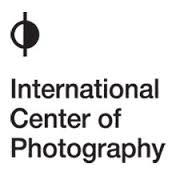 The tall tale of the overheated film-drying cabinet and the melted emulsion of Capa’s D-Day images originated with John Morris. Others bought into it, some knowingly (like Capa himself), most taking it on faith. Richard Whelan gets sole credit for initiating the lie that the sprocket-hole intrusion showed that these negatives’ emulsion had melted and slid; Cynthia Young — who has access to the same physical evidence — has perpetuated that falsehood by dragging this red herring further across the path.
The tall tale of the overheated film-drying cabinet and the melted emulsion of Capa’s D-Day images originated with John Morris. Others bought into it, some knowingly (like Capa himself), most taking it on faith. Richard Whelan gets sole credit for initiating the lie that the sprocket-hole intrusion showed that these negatives’ emulsion had melted and slid; Cynthia Young — who has access to the same physical evidence — has perpetuated that falsehood by dragging this red herring further across the path.
This qualifies as neither competent research nor responsible historianship. It constitutes the desperate Hail Mary pass of the terminally compromised and corrupted hireling. A perfect illustration of the dilemma of the bespoke, in-house curator and historian in the employ of the subject, or his or her estate, or some other entity with a vested interest in the outcome of the research.
R.I.P.
Richard Whelan died by his own hand on May 22, 2007, for reasons unknown to me and on which I do not care to speculate. He did so just two months before the opening of the This Is War! show and the publication of its catalogue. Cornell Capa outlived Whelan by a year and a day, passing away on May 23, 2008. They lie alongside Robert, his mother Julia, and Cornell’s wife Edith in a Quaker cemetery in Armonk, New York.
Unlike Cornell, and Robert before him, Whelan didn’t rate an obituary in the New York Times, just a brief “paid notice” sponsored by the board and staff of the ICP. David Schonauer, then editor of Popular Photography, published a more detailed tribute, “Remembering Author Richard Whelan,” on behalf of himself and the magazine’s staff.
Because I value loyalty, I wish I could celebrate Whelan’s devotion to defending Capa’s reputation no matter what, even at the cost of his own. Something in me wants to find a redeeming nobility, and thus tragedy, in Whelan’s final actions in support of the Capa myth just before ending his life — the steadfast footsoldier dutifully following his commander’s final order, then falling on his own sword. But, in the last analysis, I see only pathos.
•
(For an index of links to all posts in this series, click here.)



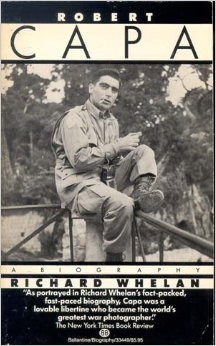
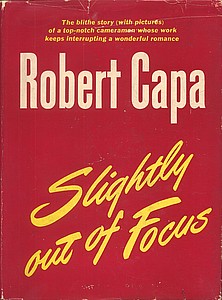
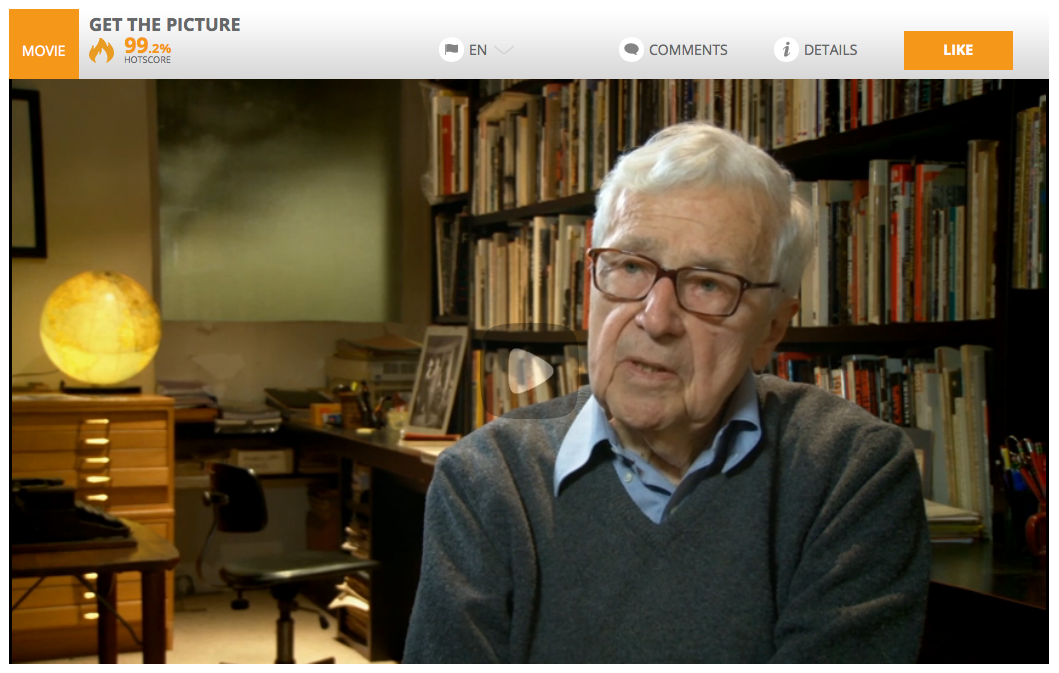
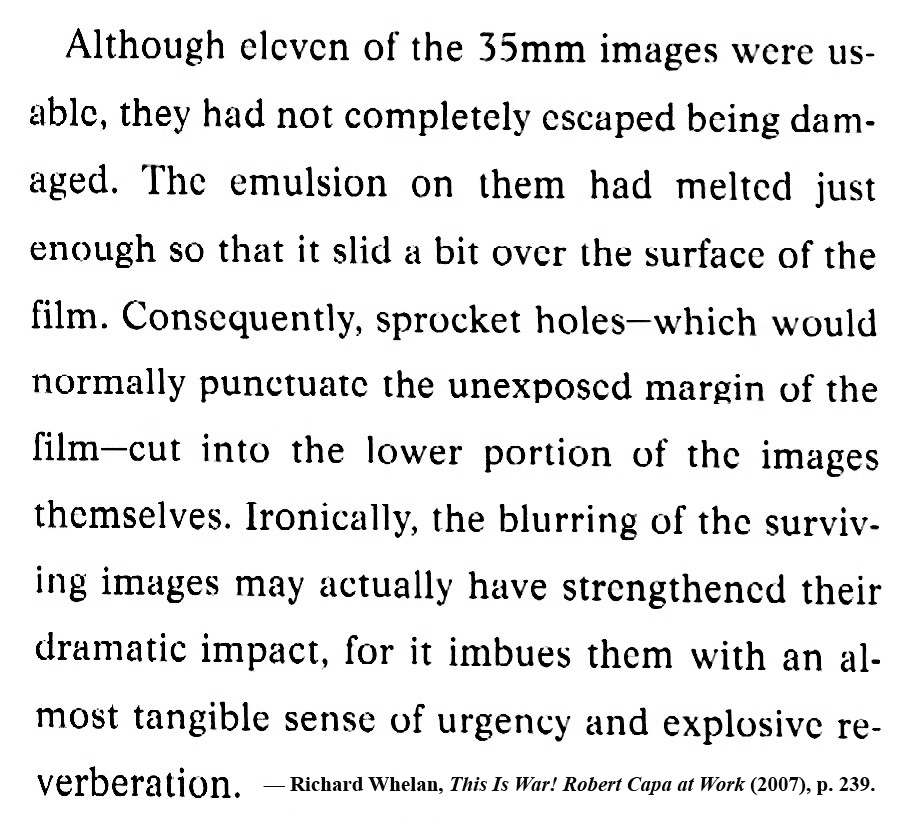
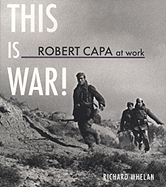
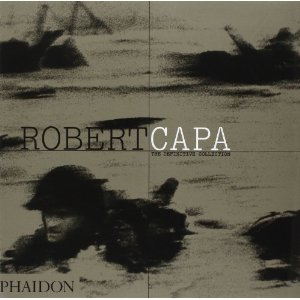
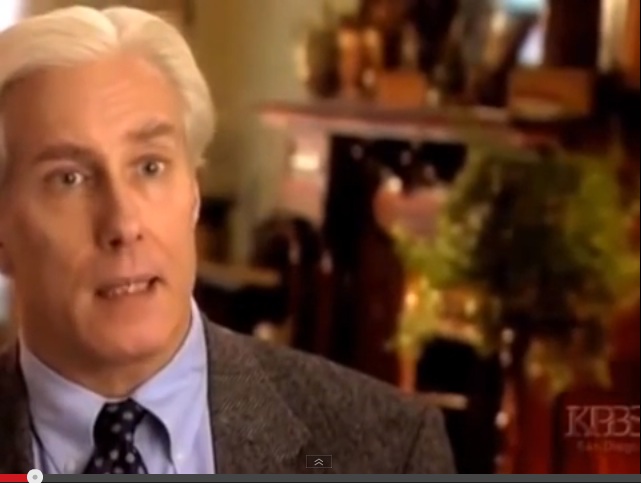




from Russian picture editor)
Dear Coleman!
This is an automatic translation. With great pleasure to read your text about the photographer Robert Capa during the 1944 D-day. I was always embarrassed by the question – how could slide emulsion with Kodak film, when it was clearly evident that she over exposed? As for the perforation – it is not a defect camera, and the different cassettes.
Soviet photographers were not branded cartridges for film and enclosed under the handle rewinding puck – otherwise the image climbs perforation. In Bresson is also seen – in its early photographs
Thank you very much for debunking the myth.
A quick online search informs me that this reader is a press photographer with the daily Russian newspaper Komsomolskaya Pravda, and a lecturer in the photojournalism department of the Faculty of Journalism, Moscow State University.
Exciting to see how widely this blog gets read.
The machine translation has obviously garbled this a bit. I have a sense that this reader hasn’t finished the full series so far; we abandoned the idea that Capa’s negatives were overexposed (or underexposed, or damaged in any way) when we discovered that the samples in the spring 2014 TIME video were fakes. At present, I see no reason to assume that any of Capa’s pre-invasion or D-Day negatives suffered from any exposure problems or got damaged during processing in any way.
However, from the last paragraph I gather that sprocket-hole intrusion into the image area of 35mm negatives occurred regularly with Russian cameras, resulting from Russian photographers bulk-loading their Russian-made film into cassettes. If I read him correctly, he indicates that one can also find this same effect in early negatives by Henri Cartier-Bresson. I can’t verify that at present, but will do so if the opportunity presents itself.
Here’s a quote about HCB from a piece I published in 1999:
As a French intellectual, Cartier-Bresson not surprisingly had clear and unbending ideas about photography. For him the camera was an instrument to seize an instant from the flux, and it was at this point of making the exposure that the photograph was created. He refused to allow the vision that he had then to be altered by cropping, insisting that his printer use the whole negative and show the black border produced by its edge around the frame.
Certainly in his early years he had little interest in the print as an object (some of the most highly prized ‘vintage’ prints are frankly poor). The print was just a means to realise the vision rather than being seen as an art object.
On the older Leica bodies it was easy to misalign film when loading in a hurry; one of his best pictures from Ireland shows a religious procession behind a banner; along its base are a series of sprocket holes partly intruding into the picture which continues on the film in the gaps between them. The effect is like crenellation, accidentally reinforcing the grim and military nature of the scene.
==============
I think it is the picture
http://www.magnumphotos.com/C.aspx?VP3=SearchResult&VBID=2K1HZOQWIAZNLA&SMLS=1&RW=1027&RH=794
which Magnum now distribute without the sprocket holes.
IRELAND. Munster. County Kerry. Tralee. 1952.